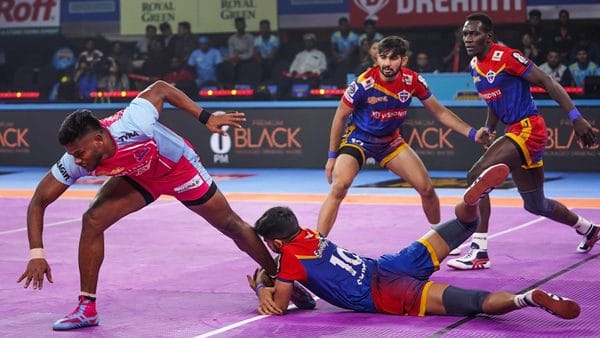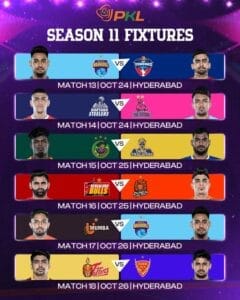
Indian Kabaddi: A Resurgent Force in Sports
In a remarkable turn of events, kabaddi has surged back into the limelight in India, captivating audiences with its thrilling matches and dynamic athletes. As the Pro Kabaddi League (PKL) enters its latest season, the sport is experiencing a renaissance, attracting both fans and young talent, while redefining its place in Indian sports culture.
 The Rise of Pro Kabaddi League
The Rise of Pro Kabaddi League
Launched in 2014, the PKL has revolutionized the perception of kabaddi, transforming it from a traditional village sport into a professional league with massive viewership. The league has grown exponentially over the years, with teams like Bengaluru Bulls, Patna Pirates, and Dabang Delhi emerging as fan favorites. The current season, now in its 11th edition, promises to be the most competitive yet, featuring 12 franchises representing various regions of India, each with their own dedicated fan base.
With thrilling matches broadcasted on national television and streaming platforms, the PKL has managed to engage millions of viewers, making kabaddi one of the most-watched sports in India. The introduction of various formats and innovations, such as the Super Tackles and Bonus Points, has added layers of excitement, ensuring that both newcomers and long-time fans remain on the edge of their seats.
 Growing Popularity and Global Reach
Growing Popularity and Global Reach
Kabaddi’s appeal is transcending borders, capturing the imagination of international audiences. Countries like Iran and South Korea have established their own leagues, showcasing the sport’s global appeal. Moreover, kabaddi exhibitions and friendly matches in the United States have sparked interest, indicating a potential for international leagues in the near future.
The Kabaddi World Cup, held every few years, has further elevated the sport’s profile on the global stage, attracting teams from across continents. As the sport continues to grow, initiatives to host more international tournaments are being discussed, positioning kabaddi as a contender for global sporting events.
 Young Talent Takes Center Stage
Young Talent Takes Center Stage
This season, a new crop of young players is set to make waves. Scouting programs and grassroots initiatives have unearthed prodigies who are not only skilled but also embody the spirit of kabaddi. Players like Neeraj Kumar, a standout raider known for his agility, and Aditi Sharma, a powerful defender, are already becoming household names, inspiring the next generation to take up the sport.
The league has become a launchpad for many aspiring athletes, offering them the opportunity to showcase their talents on a big stage. Kabaddi academies across the country are training young enthusiasts, emphasizing skill development and sportsmanship. These programs aim to nurture talent from rural areas, where kabaddi has deep cultural roots.
 Kabaddi and Gender Equality
Kabaddi and Gender Equality
The women’s kabaddi scene is also gaining momentum. The introduction of women’s leagues has been a game changer, providing female athletes with visibility and recognition. Recent tournaments, like the Women’s Kabaddi Challenge, have highlighted the prowess of women in the sport, featuring teams that compete at a high level of skill and competitiveness.
Prominent players such as Kavita Devi and Pooja Gaur have emerged as role models, breaking barriers and inspiring girls to pursue sports. With increased media coverage and sponsorship opportunities, women’s kabaddi is poised for significant growth, further enriching the kabaddi landscape in India.
 Challenges Ahead
Challenges Ahead
Despite its growth, kabaddi faces challenges, including the need for better infrastructure and increased financial backing for grassroots programs. While the PKL has drawn significant investment, there is a pressing need for local leagues and community-based programs to ensure a steady pipeline of talent.
Stakeholders are advocating for more government support to elevate the sport further, focusing on initiatives that promote kabaddi in schools and colleges. Additionally, enhancing training facilities and providing better coaching can help athletes reach their full potential.
 Cultural Significance
Cultural Significance
Kabaddi holds a special place in Indian culture, often associated with rural traditions and community bonding. The sport not only fosters physical fitness but also emphasizes teamwork and strategy, making it a holistic approach to sports. As kabaddi gains popularity, it is also being incorporated into various cultural events, festivals, and even film narratives, showcasing its deep-rooted connection to Indian society.
 Conclusion
Conclusion
As the PKL unfolds, the excitement surrounding kabaddi is palpable. With its rich heritage and bright future, kabaddi is not just a sport in India; it’s a celebration of culture, resilience, and unity. Fans are gearing up for a season filled with fierce rivalries, spectacular performances, and moments that will be etched in the annals of sports history.
As kabaddi continues to evolve, the hope is to see it attain the same level of recognition as cricket, football, and other major sports in India. With dedicated players, passionate fans, and a growing international presence, the future looks bright for kabaddi, a sport that truly embodies the spirit of India.

 The Rise of Pro Kabaddi League
The Rise of Pro Kabaddi League Growing Popularity and Global Reach
Growing Popularity and Global Reach Young Talent Takes Center Stage
Young Talent Takes Center Stage Kabaddi and Gender Equality
Kabaddi and Gender Equality Challenges Ahead
Challenges Ahead Cultural Significance
Cultural Significance Conclusion
Conclusion